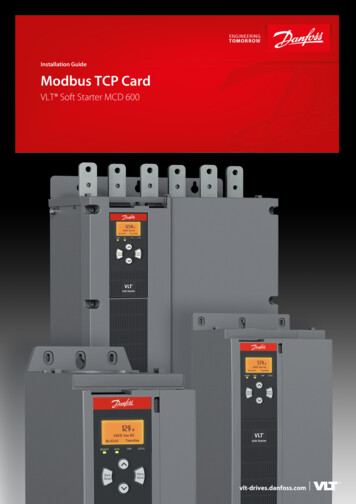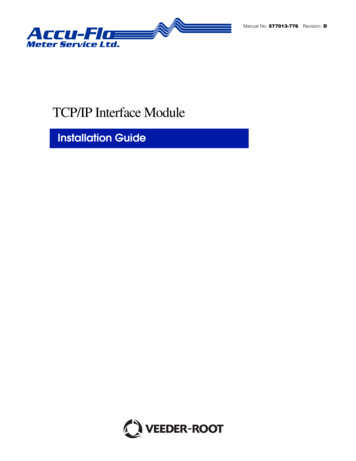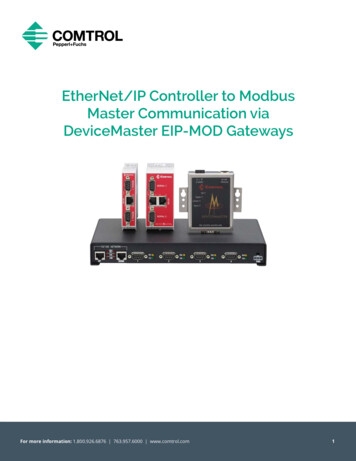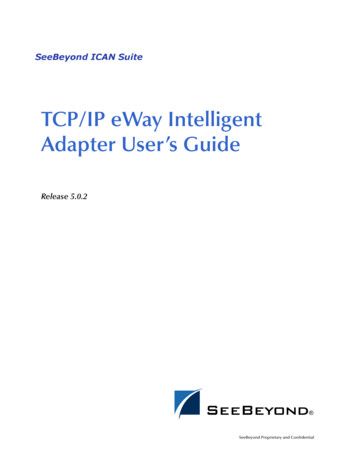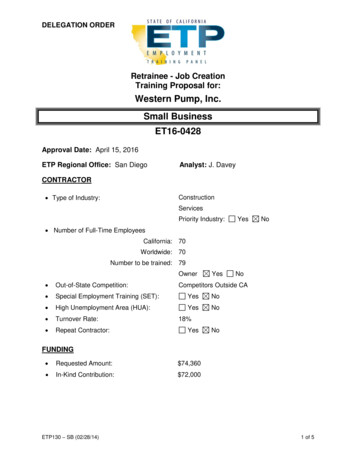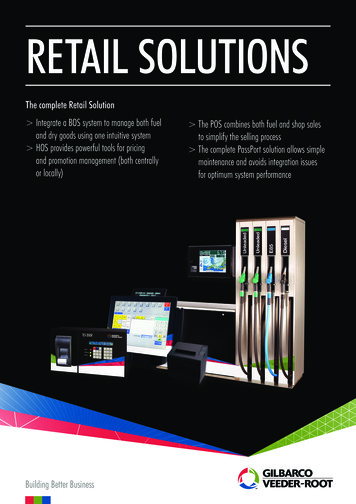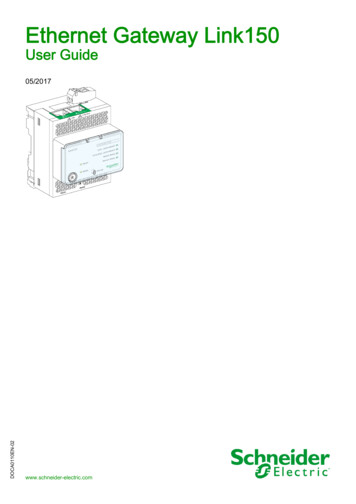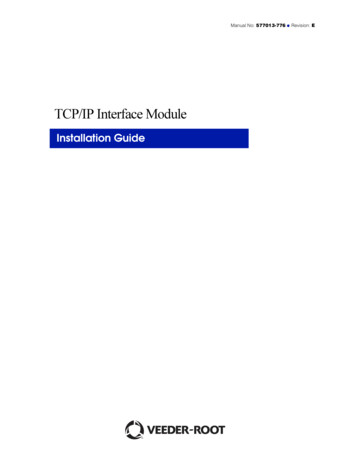
Transcription
Manual No: 577013-776TCP/IP Interface ModuleInstallation Guide Revision: E
NoticeVeeder-Root makes no warranty of any kind with regard to this publication, including, but not limited to, the implied warranties ofmerchantability and fitness for a particular purpose.Veeder-Root shall not be liable for errors contained herein or for incidental or consequential damages in connection with the furnishing,performance, or use of this publication.Veeder-Root reserves the right to change system options or features, or the information contained in this publication.This publication contains proprietary information which is protected by copyright. All rights reserved. No part of this publication may bephotocopied, reproduced, or translated to another language without the prior written consent of Veeder-Root.DAMAGE CLAIMS1.Thoroughly examine all components and units as soon as they are received. If damaged, write a complete and detailed descriptionof the damage on the face of the freight bill. The carrier's agent must verify the inspection and sign the description.2.Immediately notify the delivering carrier of damage or loss. This notification may be given either in person or by telephone. Writtenconfirmation must be mailed within 48 hours. Railroads and motor carriers are reluctant to make adjustments for damagedmerchandise unless inspected and reported promptly.3.Risk of loss, or damage to merchandise remains with the buyer. It is the buyer's responsibility to file a claim with the carrier involved.RETURN SHIPPINGFor the parts return procedure, please follow the appropriate instructions in the "General Returned Goods Policy" and "Parts Return"pages in the "Policies and Literature" section of the Veeder-Root North American Environmental Products price list.WARRANTYPlease see next page, iii. Veeder-Root 2006. All rights reserved.ii
WarrantyWarrantyTLS-350R, TLS-350 PLUS, TLS-350J AND TLS-300I/C, AND TLS-2 MONITORING SYSTEMS.We warrant that this product shall be free from defects in material and workmanship for a periodof one (1) year from the date of installation or twenty-four (24 months) from the date of invoice,whichever occurs first. During the warranty period, we or our representative will repair or replacethe product, if determined by us to be defective, at the location where the product is in use and atno charge to the purchaser. LAMPS AND FUSES ARE NOT COVERED UNDER WARRANTY.We shall not be responsible for any expenses incurred by the user.This warranty applies only when the product is installed in accordance with Veeder-Root’sspecifications, and a Warranty Registration and Checkout Form has been filed with Veeder-Rootby an authorized Veeder-Root Distributor. This warranty will not apply to any product which hasbeen subjected to misuse, negligence, accidents, systems that are misapplied or are not installedper Veeder-Root specifications, modified or repaired by unauthorized persons, or damage relatedto acts of God.If “Warranty” is purchased as part of the Fuel Management Service, Veeder-Root will maintain theequipment for the life of the contract in accordance with the written warranty provided with theequipment. A Veeder-Root Fuel Management Services Contractor shall have free site accessduring Customer’s regular working hours to work on the equipment. Veeder-Root has noobligation to monitor federal, state or local laws, or modify the equipment based ondevelopments or changes in such laws.ILS-350 MONITORING SYSTEMSWe warrant that this product shall be free from defects in material and workmanship for a periodof one (1) year from the date of installation or twenty-four (24) months from the date of invoice,whichever occurs first. During the first ninety (90) days, we or our representative will repair orreplace the product, if determined by us to be defective, at the location where the product is in useand at no charge to the purchaser. After the first ninety (90) days of the warranty period, we willrepair or replace the product if it is returned to us, transportation prepaid, within the warrantyperiod and is determined by us to be defective. We will not be responsible for any shippingexpenses incurred by the user. LAMPS AND FUSES ARE NOT COVERED UNDER WARRANTY.This warranty applies only when the product is installed in accordance with Veeder-Root’sspecifications, and a Warranty Registration and Checkout Form has been filed with Veeder-Rootby an Authorized Veeder-Root Distributor. This warranty will not apply to any product which hasbeen subjected to misuse, negligence, accidents, systems that are misapplied or are not installedper Veeder-Root specifications, modified or repaired by unauthorized persons, or damage relatedto acts of God.MODULES, KITS, OTHER COMPONENTS (PARTS PURCHASED SEPARATE OF A COMPLETECONSOLE).We warrant that this product shall be free from defects in material and workmanship for a periodof fifteen (15) months from date of invoice. We will repair or replace the product if the product isreturned to us; transportation prepaid, within the warranty period, and is determined by us to bedefective. This warranty will not apply to any product which has been subjected to misuse,negligence, accidents, systems that are misapplied or are not installed per Veeder-Rootspecifications, modified or repaired by unauthorized persons, or damage related to acts of God.We shall not be responsible for any expenses incurred by the user.iii
Table of ContentsTable of ContentsIntroductionGeneral .1TCP/IP Interface Requirements .1TCP/IP Kits .1Contractor Certification Requirements .1Related Manuals .2Safety Precautions .2TCP/IP Interface Module InstallationVerifying TCP/IP Interface Module Configuration .3Installing the TCP/IP Interface Module in the Console .4TLS-300/ProPlus Consoles .4TLS-350/ProMax Series Consoles .5TLS Console Setup of the TCP/IP Interface Module .7Connect a PC or Laptop to the TCP/IP Interface Module .9Connecting to the TCP/IP Interface Module Over a Network .9Connecting to the TCP/IP Interface Module Directly .10TCP/IP Module IP Address/Configuration Using TelnetOverview .15Entering the TCP/IP Interface Module’s IP Address .15After Network Setup of The TCP/IP Module.19TCP/IP Module IP Address/Configuration Using a BrowserProcedure .20After Network Setup of The TCP/IP Module.23Appendix A - TCP/IP Configuration Check ListTCP/IP TLS Setup Check List . A-2FiguresFigure 1.Figure 2.Figure 3.Figure 4.Figure 5.Figure 6.Figure 7.Figure 8.Figure 9.Figure 10.Figure 11.Figure 12.Figure 13.Figure 14.Figure 15.Figure 16.Figure 17.TCP/IP interface module component locations .3TLS-300/ProPlus console battery backup switch location .4Installing TCP/IP module into TLS-300/ProPlus console .5TLS-350/ProMax Series console battery backup switch location .5TLS-350/ProMax Series TCP/IP module installation .6Installing TCP/IP Module in TLS-350/ProMax Com Bay Slot 4 .7Network connection .9Locating network connection/activity LEDs .10Direct connect using ethernet crossover cable .11Network Screen .12TCP/IP Properties dialog box .12Local Area Connection Status Screen .13Local Area Connection Properties Screen .13Internet Protocol TCP/IP Properties dialog box .14Telnet Setup Menu .16Web Browser Login .20Web Manager Interface .21iv
IntroductionGeneralThis manual contains procedures to install a TCP/IP Interface Module into the following consoles: Veeder-Root TLS-3XX consoles Red Jacket ProPlus and ProMax consolesIf this is a new installation or if site preparation is necessary, refer to the console’s Site Preparation and Installationmanual, or contact your Veeder-Root representative for assistance.TCP/IP Interface RequirementsMinimum system requirements for TCP/IP Interface Module operation are listed below: Console system software: Version 15 or higher - Version 21 or higher is recommended. Network connection to a PC requires a hub. Connecting to a hub requires a straight CAT 5 cable. Direct connection to a laptop requires an ethernet crossover cable. Connection to a LAN or WAN. Knowledge of networking.TCP/IP Kits TLS-300/ProPlus console kit (P/N 330020-424):- TCP/IP module (P/N 331871-001)- #4-40 x 0.312” taptite screw - T-10 Torx drive (P/N 510500-414)- Installation Guide (P/N 577013-776) TLS-350/ProMax console kit (P/N 330020-425):- TCP/IP module (P/N 331870-001)- Wiring harness (P/N 330584-001)- Installation guide (P/N 577013-776)Contractor Certification RequirementsVeeder-Root requires the following minimum training certifications for contractors who will install and setup theequipment discussed in this manual:Level 1Contractors holding valid Level 1 Certification are approved to perform wiring and conduit routing,equipment mounting, probe and sensor installation, tank and line preparation, and line leak detectorinstallation.Level 2/3 Contractors holding valid Level 2 or 3 Certifications are approved to perform installation checkout,startup, programming and operations training, troubleshooting and servicing for all Veeder-Root TankMonitoring Systems, including Line Leak Detection and associated accessories.Warranty Registrations may only be submitted by selected Distributors.1
IntroductionRelated ManualsRelated Manuals576013-623TLS-3XX/ProPlus/ProMax Series System Setup manual576013-879TLS-3XX/ProPlus/ProMax Series consoles Site Prep and Installation GuideSafety PrecautionsThe following safety symbols are used throughout this manual to alert you to important safety hazards andprecautionsEXPLOSIVEFuels and their vapors are extremely explosive ifignited.ELECTRICITYHigh voltage exists in, and is supplied to, the device.A potential shock hazard exists.TURN POWER OFFLive power to a device creates a potential shockhazard. Turn Off power to the device and associated accessories when servicing the unit.READ ALL RELATED MANUALSKnowledge of all related procedures before you beginwork is important. Read and understand all manualsthoroughly. If you do not understand a procedure, asksomeone who does.WARNINGHeed the adjacent instructions to avoid equipment damage or personal injury.WARNINGYou are working with a device in which potentially lethal voltages may bepresent.Death or injury may result if safety precautions are not followed.1. Read all instructions and warnings.2
TCP/IP Interface Module InstallationInstallation of the TCP/IP Interface module consists of:1. Verifying the module’s configuration (Complete the checklist in Appendix A at this time),2. Installing the module in the TLS-300 console (page 4) or the TLS-350 console (page 5),3. Performing setup of the module in the TLS (page 7), and4. Setting up the module’s IP Address/Configuration using either Telnet (page 15) or a browser (page 20).Verifying TCP/IP Interface Module ConfigurationKey components of the TCP/IP Interface module are shown in Figure 1.IMPORTANT! Write down the ethernet address from the label on the back of the TCP/IP board. Youwill need to enter this number for the TCP/IP board’s hardware address in the module’s IP Address/Configuration procedure later in this manual (also record the rev of the board as it may also beneeded).6781RXGRNJ1TXREDLTRX XPort2500-20-4A-82-54-CDJ2 J3INT CL4RESET3LTRX XPort900-20-4A-82-54-CDXPXXXXXXX-XX Rev. A11Patent PendingXXXXXcab&dim\tcpip2.eps10Figure 1. TCP/IP interface module component locationsLegend for numbered boxes in Figure 11.2.3.4.5.6.7.8.9.End plate for TLS-300/ProPlus console TCP/IP module.RJ-45 Connector (typical both end plates)Reset button access (typical both plates)End plate for TLS-350/ProMax console TCP/IP moduleNetwork connection/activity LEDs (typical both end plates)J1 ConnectorJ2 Jumper - InterruptJ3 Jumper - Chip SelectWrite down the ethernet address from the label on the LTRX XPort module (in this example, 00-20-4A-82-54-CD). Youwill need this address for the TCP/IP module setup.10. Also record the rev number (in this example A11). It may be needed for the TCP/IP module setup.3
TCP/IP Interface Module InstallationInstalling the TCP/IP Interface Module in the ConsoleInstalling the TCP/IP Interface Module in the ConsoleTLS-300/PROPLUS CONSOLES1. Open the left door of the console (see Figure 2). Verify that the battery backup switch is in the On position,then turn Off power to the console.2. Remove knockout blank from left bottom of console. Slide in the configured TCP/IP Interface Module until themotherboard connector is snugly seated and the left edge of the module’s bracket is in the notch cutout in theleft side of the console. Attach securing screw from kit (see Figure 3). Leave the console door open.11Legend for numbered boxesin Figure 2S13.Connector for TCP/IPmoduleS21 RELAYRATINGS:FORM CCONTACTS120 VAC,2A Max; or24 VDC,2 A Max.WARNING: TO INSUREINTRINSIC SAFETY,THIS COVER MUSTNOT BE REMOVED.WARNINTHISBARRIERGROUNDINPUTRemove knockout blank toinstall TCP/IP module.12 NC1 NORELAY2.CNC2 NOCLACBattery backup switch (S1)shown in ‘On’ position (toleft)OPEN1.1 2 3 4OFFGN32Figure 2. TLS-300/ProPlus console battery backup switch location4
TCP/IP Interface Module InstallationInstalling the TCP/IP Interface Module in the ConsoleLegend for numbered boxesin Figure 31.TX (red)2.RX (green)3.Bracket secured in notch4.Remove blank in consolebase for access to module'splug-in connector5.#4-40 x 0.312” taptitescrew - T-10 Torx drive(P/N 510500-414)6.Module bracket7.Module plugs into maleconnector on motherboard17263cab&dim\tcpip300.eps45Figure 3. Installing TCP/IP module into TLS-300/ProPlus consoleTLS-350/PROMAX SERIES CONSOLESOFF1. Open the left door of the console. Verify that the battery backup switch (SW1) is in the ‘On’ position (seeFigure 4), then turn off power to the console.Legend for numberedbox in Figure 41.Battery backup switch(S1) shown in ‘On’position (up).11 2 3 4OPENSW1SW2cab&dim\tcpip2fig3.epsFigure 4. TLS-350/ProMax Series console battery backup switch location5
TCP/IP Interface Module InstallationInstalling the TCP/IP Interface Module in the Console2. Installing the TCP/IP module in slots 1 - 3 (Preferred Location)The TCP/IP module can be installed in any empty slot of the com bay card cage, but the module’s default settings require that it be installed in slots 1 - 3.If your console has a snap connector which secures the cover plate in the card cage, pull it out and lift out thecover plate. If your console has “knockout” cover plates, open the printer door and insert a flat blade screwdriver in the slot provided in the front of the cover plate you are removing and twist it to break the front set ofmetal securing tabs (ref item 2 in Figure 5). Once the front tabs are broken, carefully move the loosened endof the plate up and down until the rear set of securing tabs break. Remove and discard the cover plate. Slidethe module into the open slot until the motherboard connector is snugly seated. Do not apply excessive forcewhen installing the module. With your thumb, push in the black retaining fastener on the end plate until itsnaps into the hole in the card cage.1Legend for numberedboxes in Figure 51.Com bay card cage2.Com slot cover plate3.Module slots 1 - 44.24-pin board connector onTCP/IP module1cab&dim\tcpipins.eps423342Figure 5. TLS-350/ProMax Series TCP/IP module installation3. Installing the TCP/IP module in slot 4 (Alternate Location)If slots 1 - 3 are in use, or if you want to free up slots 1 - 3 for other modules, the TCP/IP module can be installed in slot 4. To use slot 4, you must move jumpers J2 and J3 on the module onto the 2 top pins, and connect the cable from the kit (P/N 330584-001) to connector J1 on the TCP/IP module and to connector J6 onthe console’s ECPU board (see Figure 6). Note: if the TCP/IP module is installed in slot 4, the displayed slot number (X) will be 5.4. Verify that the RJ-45 plug in the module’s bracket is accessible through the slot opening in the bottom of theconsole.5. When you are finished, make sure any unused slots in the com cage have a blank end plate installed. Leavethe console door open.6
TCP/IP Interface Module InstallationTLS Console Setup of the TCP/IP Interface ModuleLegend for numberedboxes in Figure 61.J2/J3 jumper positions ifinstalling TCP/IP modulein slots 1-3 (defaultpositions)2.Move jumpers J2/J3 onto 2top pins if installing TCP/IP module in slot 43.4.J1 connectorInterconnecting cable fromthe kit (P/N 330584-001)J6 on ECPU board5.2134534J2 J3RXGRNJ11TXREDLTRX XPort00-20-4A-82-54-CDINT CLJ2 J3INT CLJ2 J3RESET2cab&dim\350tcpipins.epsINT CLFigure 6. Installing TCP/IP Module in TLS-350/ProMax Com Bay Slot 4TLS Console Setup of the TCP/IP Interface Module1. Close and secure the console front door. Restore power to the console.2. You will need to know what version software is installed in the console to properly setup the TCP/IP module.Press the front panel MODE key to access Diag Mode. Press FUNCTION key to access System Diagnostic:SYSTEM DIAGNOSTICPRESS STEP TO CONTINUEPress the STEP key to view the software revision level:SOFTWARE REVISION LEVELVERSION XYY.XXWhere YY equals the console’s installed software. For example, if the version is 123.02, the software versionis 23.7
TCP/IP Interface Module InstallationTLS Console Setup of the TCP/IP Interface Module3. Press the front panel MODE key to access the Setup Mode. Press the FUNCTION key to accessCommunications Setup.4. In Communications Setup, press STEP until you see Port Settings, then press ENTER to display themessage::COMM BOARD: X (Type)BAUD RATE: 1200If necessary, press the TANK/SENSOR key until you see the message above, where X the slot number inwhich you installed the TCP/IP Interface Module, and Type S-SAT or RS-232. Note: for TLS-350/ProMax consoles only - if the TCP/IP module was installed in slot 4 of the Com Bay card cage, thedisplayed slot number (X) will be 5.5. Depending on displayed board type (S-SAT or RS-232) and the console’s installed software revision level,select the com board setup parameters shown in Table 1, Table 2, or Table 3 as applicable.Table 1. Com Setup Selections - S-SAT board type & V15 - V20 console softwareCom Setup ParameterSettingBaud Rate9600ParityNONEStop Bit1 STOPData Length8 DATARS-232 END OF MESSAGEDISABLEDTable 2. Com Setup Selections - S-SAT board type & V21 & later console softwareCom Setup ParameterSettingBaud Rate9600ParityNONEStop Bit1 STOPData Length8 DATACode (security)DISABLEDDTR NORMAL STATEHIGHRS-232 END OF MESSAGEDISABLED8
TCP/IP Interface Module InstallationConnect a PC or Laptop to the TCP/IP Interface ModuleTable 3. Com Setup Selections - RS-232 board type and V15 & later console softwareCom Setup ParameterSettingBaud Rate9600ParityNONEStop Bit1 STOPData Length8 DATACode (security)DISABLEDRS-232 END OF MESSAGEDISABLEDConnect a PC or Laptop to the TCP/IP Interface ModuleThere are two ways you can connect a PC to the module: Over a network (LAN, WAN), or DirectlyCONNECTING TO THE TCP/IP INTERFACE MODULE OVER A NETWORK1. Connect the desktop or laptop to the TCP/IP Interface Module as shown in Figure 7. Insert the RJ-45 plug ofthe network CAT 5 cable into the RJ-45 connector in the end plate of the TCP/IP module.Legend For Numbered BoxesIn Figure 71.PC2.Plugs into PC Ethernet card3.Ethernet cable4.Hub43265ALARMWARNING5.Do not use uplink connector6.Tank Gauge7.Plugs into RJ45 connector inend plate of TCP/IP module8.POWERT1: PREMIUM UNLEADEDVOLUME 4208ULLAGE 579290% ULLAGE 4792TC VOLUME 4194HEIGHT 41.02WATER VOL 0WATER 0.00TEMP 65.0GALSGALSGALSGALSINCHESGALSINCHESDEG FT1: REGULAR GASOLINEVOLUME 9038ULLAGE 96290% ULLAGE 0TC VOLUME 8950HEIGHT 81.37WATER VOL 28WATER 1.37TEMP 74.9GALSGALSGALSGALSINCHESGALSINCHESDEG Fcab&dim\tcpipnc.eps18Ethernet cable7Figure 7. Network connection2. Locate the 2 LEDs on the top edge of the RJ-45 connector on the module’s end plate (see Figure 8).9
TCP/IP Interface Module InstallationConnect a PC or Laptop to the TCP/IP Interface ModuleLegend for numbered box inFigure 81.12Network connection/activity LEDscab&dim\tcpip2led.epsFigure 8. Locating network connection/activity LEDsDepending on network connection speed, the left or right LED on the top edge of the RJ-45 connector shouldremain ‘On’ when a proper connection is made (ref. Table 4).Table 4. Network Connection/Activity LED Codes (ref. view in Figure 8)Left LEDRight LEDMeaningOffOffOffSolid amberOffBlinking amberOffSolid greenOffBlinking greenSolid amberOff10Base-T half-duplex linkBlinking amberOff10Base-T half-duplex; activitySolid greenOff10Base-T full-duplex; linkBlinking greenOff10Base-T full-duplex; activityNo link100Base-T half-duplex link100Base-T half-duplex; activity100Base-T full-duplex link100Base-T full-duplex; activityAfter confirming a successful link between the PC and the TCP/IP module, proceed to the either the IP Address/Configuration section using Telnet or using a browser as desired.CONNECTING TO THE TCP/IP INTERFACE MODULE DIRECTLYConnect the laptop to the TCP/IP Interface Module as shown in Figure 9. Insert the RJ-45 plug of the ethernetcrossover cable into the RJ-45 connector in the end plate of the TCP/IP Interface Module. Important! you mustuse an ethernet crossover cable.10
TCP/IP Interface Module InstallationConnect a PC or Laptop to the TCP/IP Interface ModuleLegend For Numbered Boxes InFigure 91.Plugs into RJ45 EthernetAdaptor in Laptop2.Laptop3.You MUST use an Ethernetcrossover cable!4.Plugs into RJ45 connector inend plate of TCP/IP module5.5ALARM31Tank GaugeWARNINGPOWERT1: PREMIUM UNLEADEDVOLUME 4208ULLAGE 579290% ULLAGE 4792TC VOLUME 4194HEIGHT 41.02WATER VOL 0WATER 0.00TEMP 65.0GALSGALSGALSGALSINCHESGALSINCHESDEG FT1: REGULAR GASOLINEVOLUME 9038ULLAGE 96290% ULLAGE 0TC VOLUME 8950HEIGHT 81.37WATER VOL 28WATER 1.37TEMP 74.9GALSGALSGALSGALSINCHESGALSINCHESDEG F42consoles\tcpipdc.epsFigure 9. Direct connect using ethernet crossover cableLocate the 2 LEDs on the top edge of the RJ-45 connector on the module’s end plate (see Figure 8 on page 10).Depending on the network card installed in the laptop, the left or right LEDs on the top edge of the RJ-45connector should remain ‘On’ when a proper connection is made as shown in Table 4.Before entering the TCP/IP Interface Module’s IP Address enter a static IP Address in your connected laptop. IPAddress setup procedures for both Windows 98 and 2000 are discussed in this section. Windows ME or XP iconor window labeling may be only slightly different. Please check those operating system’s manuals to verify theirmethod of locating the Local Area Connection status/properties dialog boxes and changing IP Addresses.Setting Your PC’s IP Address for Direct Connect (Windows 98)1. Connect your laptop to the TCP/IP card as shown in Figure 9 above. Go to your laptop’s Control Panel folderand doubleclick the ‘Network’ icon to display the Network screen (Figure 10)11
TCP/IP Interface Module InstallationConnect a PC or Laptop to the TCP/IP Interface ModuleFigure 10. Network Screen2. In the ‘The following network components are installed.’ window, highlight TCP/IP and then click theProperties button to display the TCP/IP Properties dialog box (Figure 11).Figure 11. TCP/IP Properties dialog box3. Click the Use the following IP Address radio button and enter an IP Address and Subnet mask for yourlaptop. You can use an IP address that is one digit off from the customer supplied IP Address you will assignto the console’s TCP/IP Interface Module. For example, if the IP Address for the TCP/IP module is 10.2.1.51,you would enter 10.2.1.50 for the laptop’s IP Address. You also need to enter a Subnet mask. Use the sameSubnet mask that is shown in Figure 11 above (255.255.255.0).Note: Prior to reconnecting your laptop to a network, you will need to select the Obtain an IP address automatically radio button as shown in Figure 11 above.4. You are now ready to enter the TCP/IP Interface Module’s IP Address.5. Proceed to the IP Address/Configuration section using Telnet or using a browser as desired.12
TCP/IP Interface Module InstallationConnect a PC or Laptop to the TCP/IP Interface ModuleSetting Your Laptop’s IP Address for Direct Connect ( Windows 2000)1. Connect your laptop to the TCP/IP module as shown in Figure 9 on page 11 above. Go to your laptop’sControl Panel folder and doubleclick the ‘Network and Dial-up Connections’ icon.2. Select Local Area Connection and the status screen displays (Figure 12).Figure 12. Local Area Connection Status Screen3. Click the Properties button and the Local Area Connection Properties screen displays (Figure 13).Figure 13. Local Area Connection Properties Screen4. In the ‘connections or components used check list’ window, highlight Internet Protocol (TCP/IP) and then clickthe Properties button to display the Internet Protocol TCP/IP Properties dialog box (Figure 14).13
TCP/IP Interface Module InstallationConnect a PC or Laptop to the TCP/IP Interface ModuleFigure 14. Internet Protocol TCP/IP Properties dialog box5. Click the Use the following IP Address radio button and enter an IP Address and Subnet mask for yourlaptop. You can use an IP address that is one digit off from the customer supplied IP Address you will assignto the console’s TCP/IP Interface Module. For example, if the IP Address for the TCP/IP module is 10.2.1.51,you would enter 10.2.1.50 for the laptop’s IP Address. You also need to enter a Subnet mask. Use the sameSubnet mask that is in the example in Figure 14 above (255.255.255.0). Click OK to accept your entries.Note: Prior to reconnecting your laptop to a network, you will need to select the Obtain an IP address automatically radio button shown in Figure 14 above.6. Proceed to the IP Address/Configuration section using Telnet or using a browser as desired.14
TCP/IP Module IP Address/Configuration Using TelnetOverviewTelnet and ARP are utilities available in Windows operating systems and are used in the TCP/IP addressingprocedure:Telnet - Telnet is a terminal emulation program for TCP/IP networks such as the Internet. The Telnet program runson your computer and connects your PC to a server on the network. You can then enter commands through theTelnet program and they will be executed as if you were entering them directly on the server console. This enablesyou to control the server and communicate with other servers on the network.ARP - ARP is a TCP/IP protocol used to convert an IP address into a physical address (called a DLC address),such as an Ethernet address. A host wishing to obtain a physical address broadcasts an ARP request onto theTCP/IP network. The host on the network that has the IP address in the request then replies with its physicalhardware address. ARP will only work when the console and PC share the same subnet.Port Number - This setting represents the source port number in TCP connections. It is the number that identifiesthe channel for remotely initiating connections. The range of permissable port numbers is 1 - 65535, except for thefollowing reserved port numbers:Reserved Port Numbers1 - 1024999914000-140093070430718NOTE: Do not use any of the reserved port numbers on any version of the TCP/IP board.NOTE: In addition to the IP address configuration instructions provided in this manual, it may also bepossible to use the Lantronix device installer found in the Lantronix website (www.lantronix.com) toconfigure your TCP/IP module’s IP address.Entering the TCP/IP Interface Module’s IP AddressWith the PC connected to the TCP/IP Interface Module as discussed in the previous secton, perform the stepsbelow.1. At the DOS command prompt type (the spaces between words and letters in all entries must be entered asshown or the add
Installation Guide TCP/IP Interface Module. ii Notice Veeder-Root makes no warranty of any kind with regard to this publication, including, but not limited to, the implied warranties
